Mogilev-Podolsky
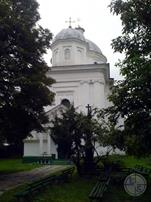 |
 |
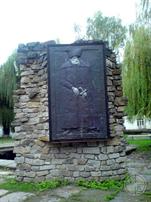 |
 |
| Greek St. George Church, 19. | Jeremiah | The monument to John Lennon. It's hard to say what he was doing. Maybe it would put a statue of Lenin, and the sculptor was deaf?)) |
Mogilev-Podolsky, 2012
The first information on the settlement on the site of today of Mogilev-Podolsky are 1450 town was founded in 1595 with the cheerful moldovaninom Jeremiah name Tomb. It was he who built a castle on the site, and later gave it to his son in law, Polish-Ukrainian oligarch Stefan Potocki. To make a relative pleasant, Potocki called the city Mogilev. In the future, the city was called Mogilev-on-Dniester and became a district center.
In 1795, the Russian government has made Potocki offer that was impossible to refuse. Mogilev was bought in Poland and annexed to the Russian Empire. In 1796 he received the status of a town as part of Podolia.
In the second half of the XIX century thanks to the development of navigation on the Dniester Mogilev became the center of the grain trade in Transnistria. In 1881, the city began construction of the railway, and then began to grow Mogilev accelerated pace.
Modern their name - Mogilev-Podolsky - the city was already during the Soviet regime.
In 1795, the Russian government has made Potocki offer that was impossible to refuse. Mogilev was bought in Poland and annexed to the Russian Empire. In 1796 he received the status of a town as part of Podolia.
In the second half of the XIX century thanks to the development of navigation on the Dniester Mogilev became the center of the grain trade in Transnistria. In 1881, the city began construction of the railway, and then began to grow Mogilev accelerated pace.
Modern their name - Mogilev-Podolsky - the city was already during the Soviet regime.
The first mention of Jews living in Mogilev-Podolsky refers to 1637 Mogilev-Podolsky Jewish population was destroyed in the 1648-49 biennium. Cossacks B. Khmelnitsky.
In the second half of the 17th century. Jews again settled in the city. In 1740-ies. Jews owned 170 houses; in 1776, two synagogues were built. In 1765, in Mogilev-Podolsky and around 957 Jews lived - the poll tax payers.
Since 1796 Mogilev-Podolsky - the county town of Podolsk province.
In 1808, father and son, D. and C. H. Stein moved from Slopkovits in Mogilev-Podolsky its publishing books in Hebrew. Publisher operated until 1819, releasing 24 books.
In 1847, in Mogilev-Podolsky lived 5411 Jews in 1897 - 12 344 Jews (55.3% of the population). In 1867, in Mogilev-Podolsky 16 functioning synagogues and houses of prayer; in the 1851-74 biennium. There was a state-owned Jewish School. Among the Jews there were many artisans and merchants. In the early 20th century. Mogilev-Podolsky had six Jewish male and female schools, Talmud Torah, the synagogue and 17 prayer houses, Jewish Hospital.
In the second half of the 17th century. Jews again settled in the city. In 1740-ies. Jews owned 170 houses; in 1776, two synagogues were built. In 1765, in Mogilev-Podolsky and around 957 Jews lived - the poll tax payers.
Since 1796 Mogilev-Podolsky - the county town of Podolsk province.
In 1808, father and son, D. and C. H. Stein moved from Slopkovits in Mogilev-Podolsky its publishing books in Hebrew. Publisher operated until 1819, releasing 24 books.
In 1847, in Mogilev-Podolsky lived 5411 Jews in 1897 - 12 344 Jews (55.3% of the population). In 1867, in Mogilev-Podolsky 16 functioning synagogues and houses of prayer; in the 1851-74 biennium. There was a state-owned Jewish School. Among the Jews there were many artisans and merchants. In the early 20th century. Mogilev-Podolsky had six Jewish male and female schools, Talmud Torah, the synagogue and 17 prayer houses, Jewish Hospital.
In October 1905, in the city there was a pogrom.
During the civil war in Russia in the 1917-21 biennium. Jews suffered greatly from the activities of various changing powers. In December 1917, in Mogilev-Podolsky pogrom took place, hosted by the soldiers of the Polish Corps Yu-Dovbor Musnitski. In the fall of 1918, it lasted for three days pogrom, which was organized by the Armed Forces of the Russian south. To stop the massacre the Jews had to pay a large indemnity.
At the beginning of the 1920s. Mogilev-Podolsky operated organization Hye-Halutz, many of whose members immigrated to Eretz Israel.
After the establishment of Soviet power all Jewish institutions in Mogilev-Podolsk were gradually eliminated.
In 1926, the city had 9622 Jewish (41.8%).
In 1939, in Mogilev-Podolsky lived 8703 Jews (39.8% of the population).
During the civil war in Russia in the 1917-21 biennium. Jews suffered greatly from the activities of various changing powers. In December 1917, in Mogilev-Podolsky pogrom took place, hosted by the soldiers of the Polish Corps Yu-Dovbor Musnitski. In the fall of 1918, it lasted for three days pogrom, which was organized by the Armed Forces of the Russian south. To stop the massacre the Jews had to pay a large indemnity.
At the beginning of the 1920s. Mogilev-Podolsky operated organization Hye-Halutz, many of whose members immigrated to Eretz Israel.
After the establishment of Soviet power all Jewish institutions in Mogilev-Podolsk were gradually eliminated.
In 1926, the city had 9622 Jewish (41.8%).
In 1939, in Mogilev-Podolsky lived 8703 Jews (39.8% of the population).
Shoah
German-Romanian troops occupied Mogilev-Podolsky July 19, 1941 Part of the Jewish population managed to evacuate. On this day, he was killed about 60 Jews. Jews were ordered to wear a distinctive sign: white armbands with longitudinal blue stripes at the top and bottom and a six-pointed star between them. Judenrat was formed.
August 15, 1941 in Mogilev-Podolsky was created ghettos, where in December 1941 was 3733 the local Jews. Mogilev-Podolsky entered the Romanian occupation zone of Transnistria. In the fall of 1941 in the city had been deported more than 15,000 Jews from Bessarabia and Bukovina, which first housed in the barracks of the former Infantry Regiment, and then transferred to the ghetto.
In late 1941 an epidemic of typhus in the ghetto began. Of the officially registered patients died 1254 man. Many inhabitants of the ghetto of Mogilev-Podolsky, were deported to the Romanian concentration camp in Pechora Vinnitsa region. The prisoners were placed in the open air, they are not fed. Large numbers of people are dying every day.
In 1942, the deportees from Bessarabia and Bukovina began to receive aid from the Jewish communities of Romania. At the beginning of 1944, deported from Bessarabia and Bukovina were returned to Romania. The surviving part of local Jews was liberated by the Soviet army March 19, 1944
In 1946, in Mogilev-Podolsky, there were about three thousand Jews.
German-Romanian troops occupied Mogilev-Podolsky July 19, 1941 Part of the Jewish population managed to evacuate. On this day, he was killed about 60 Jews. Jews were ordered to wear a distinctive sign: white armbands with longitudinal blue stripes at the top and bottom and a six-pointed star between them. Judenrat was formed.
August 15, 1941 in Mogilev-Podolsky was created ghettos, where in December 1941 was 3733 the local Jews. Mogilev-Podolsky entered the Romanian occupation zone of Transnistria. In the fall of 1941 in the city had been deported more than 15,000 Jews from Bessarabia and Bukovina, which first housed in the barracks of the former Infantry Regiment, and then transferred to the ghetto.
In late 1941 an epidemic of typhus in the ghetto began. Of the officially registered patients died 1254 man. Many inhabitants of the ghetto of Mogilev-Podolsky, were deported to the Romanian concentration camp in Pechora Vinnitsa region. The prisoners were placed in the open air, they are not fed. Large numbers of people are dying every day.
In 1942, the deportees from Bessarabia and Bukovina began to receive aid from the Jewish communities of Romania. At the beginning of 1944, deported from Bessarabia and Bukovina were returned to Romania. The surviving part of local Jews was liberated by the Soviet army March 19, 1944
In 1946, in Mogilev-Podolsky, there were about three thousand Jews.
 |
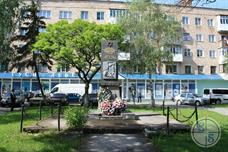 |
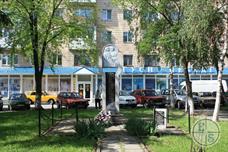 |
 |
| These are 2 of the monument in the city center | |||
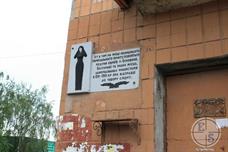 |
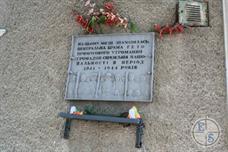 |
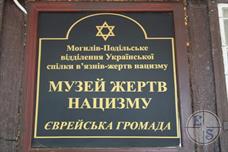 |
 |
| This is a modern bus station | The sign on the gate of the ghetto site | Museum | |
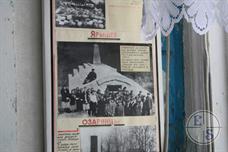 |
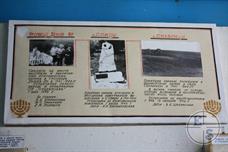 |
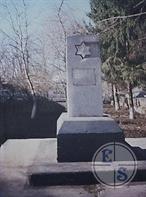 |
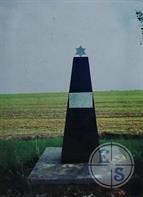 |
| Many monuments were established local community forces | |||
 |
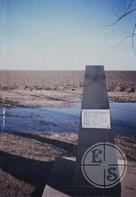 |
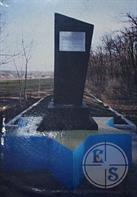 |
 |
 |
 |
 |
|
According to the 1959 census, the Jewish population of the city amounted to 4.7 thousand. People (22.5% of the total population). In 1960-ies. Mogilev-Podolsky going to minyan in a private apartment, the existence of government decided to stop. Torah scrolls, was fined on several religious Jews Jewish rites for the administration (instead of officially appointed rabbi) were confiscated, but soon the measures were repealed. Since the beginning of the 1970s. Mogilev-Podolsky operates a synagogue in a small one-story house.
In 1970, in Mogilev-Podolsky population of 4,4 thousand Jews (about 10.9% of the population), in 1989 -. 2830 Jews. In 1989-2004 gg. the vast majority of the Jews of Mogilev-Podolsky left for Israel, the US, Germany or other countries.
Since the beginning of the 1990s. Mogilev-Podolsky operates the Jewish community, is functioning synagogue - one of three in the Vinnitsa region.
In 2012, there were about 300 Jews.
In 1970, in Mogilev-Podolsky population of 4,4 thousand Jews (about 10.9% of the population), in 1989 -. 2830 Jews. In 1989-2004 gg. the vast majority of the Jews of Mogilev-Podolsky left for Israel, the US, Germany or other countries.
Since the beginning of the 1990s. Mogilev-Podolsky operates the Jewish community, is functioning synagogue - one of three in the Vinnitsa region.
In 2012, there were about 300 Jews.
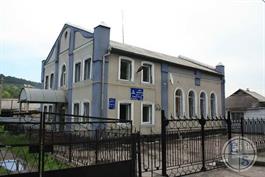 |
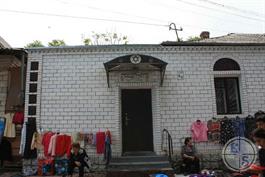 |
 |
| The former synagogue is now the Protestant Church | This modern synagogue, as can be seen next to the market |
Vinnitsa Region

My shtetl
My shtetl
Jewish towns of Ukraine
Jewish towns of Ukraine










